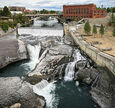Short History of Spokane, Washington

The city of Spokane is the largest in the east part of Washington. The first recorded settlement in the area was in the 1870s, and not long after that, Spokane became the county seat of Spokane County. It is also the hub for regional agriculture, mining, transportation, timber, education, and medical facilities. The city of Spokane, like other cities, had its era of development, stagnation, and revitalization.
Spokane River
The Spokane River attracted settlers to inhabit the area centuries before. The river is abounding with salmon which became the primary food of the locals, who were called the Spokanes, or "Children of the Sun."
Due to the increasing population of the whites in the area, the Spokanes were led into a much larger conflict of the Indian-white of the area. In 1908, dams and reservations were founded in the city which marked the end of the salmon-based kind of life on the Spokane River.
Due to the increasing population of the whites in the area, the Spokanes were led into a much larger conflict of the Indian-white of the area. In 1908, dams and reservations were founded in the city which marked the end of the salmon-based kind of life on the Spokane River.
Europeans Arrive
|
Missionaries and fur traders were the first Europeans to explore the area of Spokane. David Thompson traversed the watershed of the upper Columbia and was drawn not only with the beauty of the falls but also with the enormous potential of the area when it comes to the economy.
James Downing with Seth Scranton established a sawmill along the river in 1871. Further, James N. Glover and Jasper N. Matheney came looking to develop a town. The falls struck them and saw that it has a lot of economic potentials. They bought Downing's mill and continued purchasing lands in the area. |
|
Spokane as a Town
Soon enough, people began settling on the river because of the many facilities that they can take advantage of. After some time, schools, churches, banks, and other important establishments were built in the city. John J. Browne and Anthony M. Cannon were among the first businessmen who settled in the town. They aimed for real estate development, and due to the growing population, the need for hotels arise.
The Prosperous 1880s
The city grew prosperously in the area of 1880s. Spokane was incorporated in 1881 has a population of approximately 1,000 inhabitants. Railroad development, discoveries of silver, gold and lead mines contributed to the growing economy of Spokane. Also in this period, Gonzaga University and Sacred Heart Hospital were established and are still in use until now. The city became an integral hub for industrial fairs as well as agricultural conventions.
Burning and Rebuilding
The productive era of the 1880s concluded with a massive fire that ruined significant parts of the city. The good thing was many of the businesses were insured and were rebuilt immediately. The city was able to recover from the devastating event. In 1900, the town began to transition from using horses to motorized cars as a means of transportation in the area. By 1909, the city was home to 26 millionaires and many wealthy landowners
The city continues to reinvent and revitalize its economy with the development of new establishments and facilities. Malls, such as the River Park Square, universities, and convention centers were founded in the twentieth century that helped in the restoration of the city's economy.
See this website for more information.
The city continues to reinvent and revitalize its economy with the development of new establishments and facilities. Malls, such as the River Park Square, universities, and convention centers were founded in the twentieth century that helped in the restoration of the city's economy.
See this website for more information.
